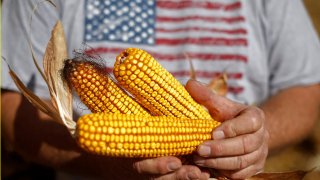
- The futures contracts traded at more than $6.50 per bushel early Monday, up more than $1 per bushel since late March.
- The price spike has come as harsh weather in the Upper Midwest has raised concerns about corn supply amid a broader rise for commodities prices.
- Rising commodity prices are also likely to stoke fears about inflation.
Corn futures jumped Monday, hitting their highest level in more than seven years and triggering a pause in trading at the Chicago Board of Trade.
The futures contracts traded at more than $6.50 per bushel early Monday, up more than $1 per bushel since late March. The price spike has come as harsh weather in the Upper Midwest has added to concerns about global corn supply amid a broader rise for commodity prices.
"With drought conditions in North and South Dakota continuing to worsen there is added risk to the 2021 planting season which could pressure supply in an already tight marketplace," Jefferies said in a note to clients earlier this month. "The two states account for a majority of the nation's wheat production, and ~7.5% of corn production, and ~10% of soybeans."
Get New England news, weather forecasts and entertainment stories to your inbox. Sign up for NECN newsletters.

Sal Gilbertie, the chief executive officer of agriculture ETF company Teucrium, said a spike in demand for grains from China has lowered global reserves, putting extra pressure on North American farms to produce a healthy crop. He pointed to data from the U.S. Department of Agriculture that showed projected corn inventory dropping.
"We know South America's not going to have a record corn crop, which means we're counting on the northern hemisphere to have a record or near-record corn crop, just to keep the inventories at a much tighter level than they were last year," Gilbertie said.
Money Report
Corn's jump comes amid a broader surge in commodity prices, with wheat futures also hitting their highest level since 2013 on Monday. Lumber futures have also soared in recent weeks.
"The price surge and the already high price level, especially in the case of corn, also reflect the nervousness in view of the current tightness on the markets, which is expected to be repeated in 2021/22," Commerzbank said in a note to clients last week.
The CME Group has price limits for different products, including equities and commodity futures, to manage intraday volatility. When a product rises or falls to a preset level, as corn futures appeared to on Monday, the exchange can temporarily halt trading.
Corn futures were up nearly 4% on Monday afternoon.
Rising commodity prices are also likely to stoke fears about inflation. The chief financial officer of General Mills said during the company's March earnings call that the food products company planned to raise prices to offset higher input costs.
Economists at the Federal Reserve and the Biden administration have said a short-term rise in inflation is expected in coming months due to several factors, including low demand caused by Covid last year and consumer spending fueled by federal stimulus. However, the price increases may prove to be transitory, and inflation could ease once the initial jolt of the reopening has passed.
The sharp rise in prices does not necessarily mean a corn shortage is imminent. According to the U.S. Department of Agriculture, the amount of corn planted through April 18 was roughly equal to the average over the past five years.
A beneficiary of rising prices for corn and other products could be agricultural companies like Archer-Daniels-Midland. The company's stock has jumped nearly 20% since the end of January, and Bank of America gave the stock a buy rating on Wednesday citing "a renewed Ag cycle that is expected to last a few years and potentially much longer."
-CNBC's Michael Bloom contributed to this report.
Become a smarter investor with CNBC Pro.
Get stock picks, analyst calls, exclusive interviews and access to CNBC TV.
Sign up to start a free trial today






